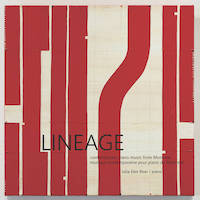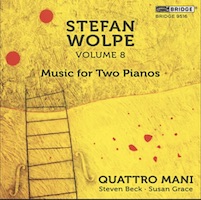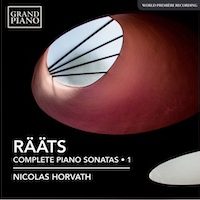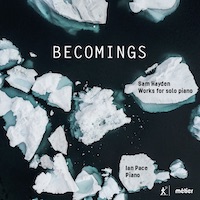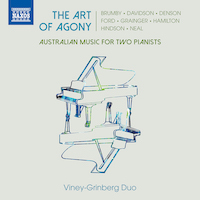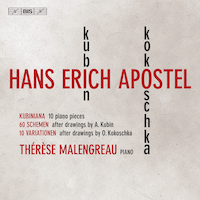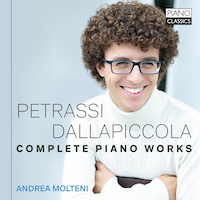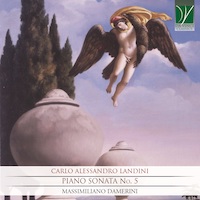Piano Factory 30.
|
Grant Chu Covell [January 2022.]
“Lineage.” Chris Paul HARMAN: 371 Chorales (2016). Brian CHERNEY: Tombeau (1996). Matthew RICKETTS: Melodia (2016-17). Reiko YAMADA: Cloud Sketches (2010). Julia Den Boer (pno). Redshift Music TK476 (1 CD) (www.redshiftrecords.org). These four pieces present contemporary piano music from Montreal. Situated in the high register, like a music box, a delicate irregular chiming pattern repeats in Harman’s 371 Chorales. The title recalls Bach, but the evidence is scant: perhaps he has plucked bits of Bach’s Chorales according to a hidden protocol. Cherney’s Tombeau immediately asserts with Messiaen-like rosy chords. In seven parts, Tombeau is dedicated to the memory of Cherney’s close friend Martin Bass, a central portrait is framed with Scherzos and Interludes. Ricketts’ Melodia is a lightly sculpted line, predominantly one or two intertwined voices in the right-hand with support from the left. True to its title, Yamada’s Cloud Sketches attempts to musically draw clouds but without being impressionistic. I admit spending some time trying to make sense of the cover image, Pietrasanta C11.56 by Caio Fonseca. Den Boer plays with conviction: These are not showy pieces, complexity is submerged under emotion and color.
“Stefan Wolpe: Volume 8.” Stefan WOLPE: March and Variations, Op. 21 (1932-33); The Man from Midian (1942); Nos. 3 and 4 from Four Studies on Basic Rows, Op. 23 (1935-36). Quattro Mani: Steven Beck, Susan Grace (pno). Bridge Records 9516 (1 CD) (www.bridgerecords.com). There’s a stylistic shift in the March and Variations about two-thirds of the way through. What had been brightly chiseled neo-classical facets suddenly become irrevocably gloomy. These unexpected persisting emotions suggest we’ve stumbled upon a story, and what had seemed a severe march and its implications segues tidily into the two-piano version of a serial but neoclassical two-act ballet about Moses, The Man from Midian. The dance music also has its double-take: The jazzy “Bacchanal” embarrasses and surprises not unlike “The Golden Calf and The Altar” in Schoenberg’s opera. You might have to replay the track and the ones around it to be sure it’s the same composer and recording. The vividness Quattro Mani brings to these pieces reveals an astonishing amount of anger. The two pieces from Op. 23 are similarly gruff, lengthy studies which must cycle through their implications. It’s easy to admire this music, but hard to love it, although Quattro Mani invite us to return.
“Complete Piano Sonatas, Vol. 1.” Jaan RÄÄTS: Piano Sonata No. 9, Op. 76 (1985; rev. 2014); Piano Sonata No. 10, Op. 114 (2000; rev. 2014); Piano Sonata No. 1, Op. 11, No. 1 (1959); Piano Sonata No. 2, Op. 11, No. 2 (1959); Piano Sonata No. 3, Op. 11, No. 3 (1959); Piano Sonata No. 4, Op. 36, “Quasi Beatles” (1969). Nicolas Horvath (pno). Grand Piano GP765 (1 CD) (www.grandpianorecords.com). Rääts (b. 1932) passed away in December of 2020, leaving a vast catalog behind him. The first of two discs, this release presents six piano sonatas. Rääts’ style is disarmingly direct, fluently alternating between minimal and modernist, drifting in and out of tonality and traditional melody and accompaniment. Satie, Antheil, Shostakovich and Nyman could be influences. To judge from these pieces, Rääts avoids dramatic styles or extracurricular programs. Most movements are tidy. Sonata No. 10 is a single six-minute statement. A few beats of this, four beats of that, quickly paced, rarely repeated, continually different. No. 9 sounds like a collage. No. 1’s first movement is an unbroken single-voice line. No. 2 concludes jazzily. Slow chords in No. 3’s Adagio hint at Schoenberg’s Farben. There are no specific Fab Four tunes in No. 4, but Rääts introduces gestures and chord progressions recalling the pop charts. I await Vol. 2.
Sam HAYDEN: Becomings (Das Werden) I-VII (2016-18); …still time… (1990); Fragment (After Losses) (2003); Piano Moves (1990). Ian Pace (pno). Metier MSV 28611 (2 CDs) (www.divineartrecords.com). Becomings plays in the big leagues with splashy modernism, inscrutable lurching, and all the vocabulary of the noisy avant-garde. It’s exhausting, and while Pace is committed, it is not easy to revisit. However, the earlier pieces set up shop well outside the complexity camp. Asking for amplification, Piano Moves gently flings dissonant bell-like chords in plodding, unsynchronized rhythms. Similarly …still time… luxuriates in piano resonance. You could say Becomings’ mechanics have distilled …still time…’s longer phrases highlighting contrasts. Although, the earlier works’ most savory aspects center around silence, whereas the rocky gestures tumble unremittingly throughout Becomings. Pace brings so much more physicality and emotion to the earlier pieces than the newer seven-part series.
“The Art of Agony: Australian music for two pianists.” Percy GRAINGER: Horkstow Grange and The Lost Lady Found from Lincolnshire Posy (1937). Robert DAVIDSON: The Art of Agony (2012). Andrew FORD: On Reflection (2012-13). Louise DENSON: Mill Life (2018). Colin BRUMBY: 3 Easy Piano Duets (1980). Gordon HAMILTON: Shorter/Longer (2015); Lullaby for Liam and Anna’s Kids (2014). Kate NEAL: Etude I (2016). Matthew HINDSON: Visible Weapon (2013). Viney-Grinberg Duo: Liam Viney, Anna Grinberg (pno, perc). Naxos 8.579075 (1 CD) (www.naxos.com). This release is more fun than its title implies. Grainger once said music is the art of agony, and lo and behold, we hear his voice in Davidson’s short piece for two pianos. Was Grainger speaking ironically? The duo echoes the composer’s vocal cadence (and a preening interviewer). Davidson’s enigma sits within two Grainger pieces, nice sounding tunes, though you’ll consider them differently after hearing what Grainger has to say. The program (most of it written for the Viney-Grinberg Duo) continues to contrast the tuneful and the darkly serious. On Reflection explores the mirroring of the two pianos in concert: both players may gesture in the same direction, but because the pianos face each other, high notes mirror low notes. Mill Life requires 22 pianos and percussion, here overdubbed for a thicket of salty microtonal activity, suggesting a day in the life of complex machinery. Brumby’s tuneful duets flow easily, melodious whereas Hamilton’s Shorter/Longer is angular as motifs expand and contract. Hamilton’s Lullaby maintains similar energy, recasting a few of the same motives. The lines in Neal’s brief two-piano Etude interlock as if a puzzle. Visible Weapon adds tape and comments upon the excessive violence we all live with, though it’s hard not to come away with the feeling that Hindson means to remind us that violence entertains us as well.
Hans Erich APOSTEL: Zehn Variationen über ein eigenes Thema, Op. 1 (1928); Kubiniana, Zehn Klavierstücke, Op. 13 (1945); Sechzig Schemen nach Zeichnungen von Alfred Kubin (Abenteuer einer Notenfeder), Op. 13a (1948-49). Thérèse Malengreau (pno). BIS BIS-2405 (1 CD) (www.bis.se). Sparked by drawings and sketches, these piano works allow us to appreciate a lesser-known Schoenberg and Berg student. Time was, the String Quartet, Op. 7, bundled with the LaSalle Quartet’s edition of Zemlinsky’s quartets, was the only Apostel on record. Ten Variations, Op. 1, was inspired by ten Oskar Kokoschka drawings. Kubiniana and the 60 Sketches were sparked by Alfred Kubin’s series of portraits, “60 Heads from Past Times.” The Op. 1 uses an original theme in ternary form, relatively tonal, but with unexpected chords, an emphasized trill, and a whole-tone gesture. The variations are expressionistic, flirting with tonality and atonality equally. The Kubin-inspired Op. 13 sets are aphoristic, a dazzling collection of chips. The ten pieces are tracked separately whereas the briefer 60 sketches are clustered in groups. Material flows between Kubiniana and the Sechzig. Malengreau delivers a vivacious intensity, and BIS provides a resonant soundstage. These are Opp. 1 and 13a’s first recordings.
“Complete Piano Works.” Goffredo PETRASSI: Partita (1926); Toccata (1933); Piccola Invenzione (1941); Invenzioni (1944); Petit Piece (1950); Oh Les Beaux Jours! (1942/1976). Luigi DALLAPICCOLA: Sonatina Canonica su “Capricci” di Niccolò Paganini (1943); Tre episodi dal balletto Marsia (1949); Quaderno musicale di Annalibera (1951-52). Andrea Molteni (pno). Piano Classics PCL10222 (2 CDs) (www.piano-classics.com). Petrassi and Dallapiccola were born the same year. Their earliest piano works reflect past styles and history. Petrassi’s four-movement Partita is crackling Neoclassical and the bittersweet Toccata is a theme and variations. Dallapiccola’s Sonatina Canonica leverages material from Paganini’s violin caprices. Both composers gravitated towards lean styles: Petrassi’s Invenzioni demonstrate atonal counterpoint whereas Dallapiccola jumped wholeheartedly into serialism as evidenced by the excerpts from the ballet, Marsia. The pair of short pieces in Petrassi’s Oh Les Beaux Jours! is playful and spontaneous, hinting at earlier efforts. Rarely heard, the 11-part Quaderno offers crafted miniatures reflecting serialism and canons.
Carlo Alessandro LANDINI: Piano Sonata No. 5 (2015). Massimiliano Damerini (pno). Da Vinci Classics C00258 (2 CDs) (www.davinci-edition.com). At two-and-a-half hours, Landini’s through-composed but repetitive single movement, with perpetually heaving motives built around diminished chords (perhaps Scriabin castoffs) is as unrelenting as a flat tire on a highway. A proponent of “slow music” meant to transport listeners from the mundane into something spiritual, Landini could be playing an elaborate joke, but no, this continually gyrating effort churns earnestly. How Damerini sustains focus is worthy of study (though the piano loses its edge towards the end). The continual tension between two against three, the occasional surprising Lisztian gesture, and the catchy twisting theme, all do help keep a listener engrossed across the gargantuan span. You may wonder how it will end, just as you may have forgotten how it began.
Apostel, Brumby, Cherney, Dallapiccola, Davidson, Denson, Ford, Grainger, Hamilton, Harman, Hayden, Hindson, Landini, Neal, Petrassi, Rääts, Ricketts, Wolpe, Yamada
[More Grant Chu Covell, Piano Factory]
[More
Apostel, Brumby, Cherney, Dallapiccola, Davidson, Denson, Ford, Grainger, Hamilton, Harman, Hayden, Hindson, Landini, Neal, Petrassi, Rääts, Ricketts, Wolpe, Yamada]
[Previous Article:
Four Poems]
[Next Article:
Used Bin Troll Tweets EEE.]
|
